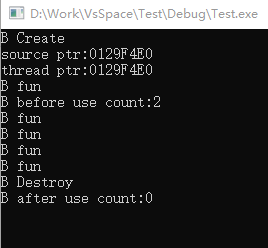C++智能指针
一、头文件
#include <memory>
二、独占智能指针unique_ptr
1、生成
//生成 1、创建空的 std::unique_ptr<int> ptr1; 2、通过指针创建 std::unique_ptr<Task> taskPtr(new iTask(22)); 3、通过make_unique创建【C++14】 std::unique_ptr<Task> taskPtr = std::make_unique<Task>(34); 4、通过移动构造创建 std::unique_ptr<Task> taskPtr1(new Task(55)); std::unique_ptr<Task> taskPtr2 = std::move(taskPtr1); 5、其他错误方式 // 编译错误 : unique_ptr 不能复制 std::unique_ptr<Task> taskPtr1 = taskPtr2; // Compile error // 编译错误 : unique_ptr 不能复制 taskPtr1 = taskPtr2; //compile error
注意:make_unique是C++14功能,建议不要使用
2、判断为空
// 方法1 if(!ptr1) std::cout<<"ptr1 is empty"<<std::endl; // 方法2 if(ptr1 == nullptr){ std::cout<<"ptr1 is empty"<<std::endl; }
3、获取
//获取关联指针 Task* task = ptr.get(); //获取关联对象 Task task = *(ptr.get());
4、常用接口
| 成员函数 | 作用 |
|---|---|
| reset() | 重置unique_ptr为空,delete其关联的指针。 |
| release() | 不delete关联指针,并返回关联指针。释放关联指针的所有权,unique_ptr为空。 |
| get() | 仅仅返回关联指针 |
5、使用场景
①、避免函数内部return时忘记delete
void fun(A* a) { std::unique_ptr<A>(a); if(xxxx){ return;//如果不是智能指针,则需要delete a然后再return } }
6、VS例子
// Test.cpp : 定义控制台应用程序的入口点。
//
#include "stdafx.h"
#include <thread>
#include <memory>
#include <iostream>
#include <assert.h>
class A
{
public:
A()
{
std::cout << "A Create" << std::endl;
}
~A()
{
std::cout << "A Destroy" << std::endl;
}
void fun()
{
std::cout << "A Fun" << std::endl;
}
private:
};
int main()
{
A* a = new A();
std::unique_ptr<A> myPtr(a);
myPtr->fun();//重载的->,可以理解为直接返回a指针
(*myPtr).fun();//直接取指向的对象,所以不再使用指针
std::unique_ptr<A> myOtherPtr = std::move(myPtr);//myPtr将指向a的权利移动给myOtherPtr,myPtr变为空指针
assert(myPtr != nullptr);
myOtherPtr.reset();
assert(myOtherPtr != nullptr);
assert(a != nullptr);
getchar();
return 0;
}
7、Qt例子
mainwindow.h:
class A
{
public:
A()
{
qDebug()<<"A";
}
~A()
{
qDebug()<<"~A";
}
};
class MainWindow : public QMainWindow
{
Q_OBJECT
public:
explicit MainWindow(QWidget *parent = 0);
~MainWindow();
private:
Ui::MainWindow *ui;
std::unique_ptr<A> uptr_AllData;
private slots:
};
mainwindow.cpp:
{
std::unique_ptr<A> tmepPtr(new A);//打印A
uptr_AllData = std::move(tmepPtr);//
}
现象:
在new A的时候打印A,在窗口关闭后,自动回收A的内存,打印~A。
8、智能指针数组
mainwindow.h
class A
{
public:
A()
{
qDebug()<<"A";
}
~A()
{
qDebug()<<"~A";
}
void print()
{
qDebug()<<"print function";
}
};
class MainWindow : public QMainWindow
{
Q_OBJECT
public:
explicit MainWindow(QWidget *parent = 0);
~MainWindow();
private:
Ui::MainWindow *ui;
queue<unique_ptr<A>> allPacket;
private slots:
void on_pushButton_clicked();
};
mainwindow.cpp
MainWindow::MainWindow(QWidget *parent) :
QMainWindow(parent),
ui(new Ui::MainWindow)
{
ui->setupUi(this);
{
unique_ptr<A> data(new A);
allPacket.push(std::move(data));
}
}
void MainWindow::on_pushButton_clicked()
{
allPacket.front()->print();
allPacket.pop();
}
现象:
在new的时候打印A,在pop之后打印~A
9、智能指针作为参数传递
①、看函数原型
②、传参
核心:转移指针所有权【std::move】,把所有权从实参传到形参
PS:
1、智能指针的核心就是在析构的时候自动帮你delete所指向的指针。
2、如果希望将此智能指针作为类的属性,那么在赋值的时候:先生成一个临时的智能指针,再用std::move来赋值给这个属性,否则就必须在声明的时候就初始化。
3、使用此智能指针的优点就是不用自己在析构函数中delete指针。【感觉缺点多多了】
三、共享智能指针share_ptr
1、例子
// Test.cpp : 定义控制台应用程序的入口点。
//
#include "stdafx.h"
#include <thread>
#include <memory>
#include <iostream>
#include <assert.h>
#include <thread>
#include<windows.h>
#define OPEN_IF 1
#define CLOSE_IF 0
class B
{
public:
B()
{
std::cout << "B Create" << std::endl;
}
~B()
{
std::cout << "B Destroy" << std::endl;
}
void fun()
{
std::cout << "B fun" << std::endl;
}
private:
};
void threadFun(std::shared_ptr<B> ptr)
{
int count = 5;
auto source = ptr.get();
std::cout << "thread ptr:" << ptr << std::endl;
#if CLOSE_IF
std::cout << "source address:" << source << std::endl;
std::cout << "current thread id:" << GetCurrentThreadId() << std::endl;
#endif
while (count--)
{
ptr->fun();
Sleep(1000);
}
ptr.reset();
std::cout << "B after use count:" << ptr.use_count() << std::endl;
}
int main()
{
B *b = new B();
std::shared_ptr<B> myPtr1(b);
std::cout << "source ptr:" << myPtr1 << std::endl;
std::thread threadA(threadFun, myPtr1);
std::cout << "B before use count:" << myPtr1.use_count() << std::endl;
threadA.detach();
myPtr1.reset();
getchar();
return 0;
}

注意:shared_ptr作为参数【函数参数、线程参数】时,不管是不是引用传递,都是拷贝复制,所以它们的计数器是同一个,所以计数+1
2、关于线程安全
shared_ptr的引用计数是线程安全的,但是指向的对象不是线程安全的。
3、原理【伪代码】
①、在类里加一个指向堆的int计数
temple<typename T> class SharedPtr { public: ... private: T *_ptr; //指向资源 int *_refCount; //指向计数,必须是堆的资源,should be int*, rather than int };
②、智能指针拷贝时计数加一
SharedPtr(SharedPtr &other) : _ptr(other._ptr), _refCount(&(++*other._refCount))
{
}
③、析构时计数减一,如果计数为0则回收资源
~SharedPtr() { if (_ptr && --*_refCount == 0) { delete _ptr; delete _refCount; } }
4、应尽量避免循环引用,shared_ptr的一个最大的陷阱是循环引用【互相引用?】,循环引用会导致堆内存无法正确释放,导致内存泄漏
默认构造函数初始化智能指针:
SharedPtr(T *obj) : _ptr(obj), _refCount(new int(1)) { } //这里无法防止循环引用,若我们用同一个普通指针去初始化两个shared_ptr,此时两个ptr均指向同一片内存区域,但是引用计数器均为1,使用时需要注意。
5、共享指针作为参数传递
class A { public: A(){qDebug()<<"A";} ~A(){qDebug()<<"~A";} }; void fun(const std::shared_ptr<A>& sp) { qDebug()<<sp.get(); } void main() { { std::shared_ptr<A> aa = std::make_shared<A>(); fun(aa); } }
打印:
A
~A
四、weak_ptr
该类型指针通常不单独使用(没有实际用处),只能和 shared_ptr 类型指针搭配使用。甚至于,我们可以将 weak_ptr 类型指针视为 shared_ptr 指针的一种辅助工具,借助 weak_ptr 类型指针, 我们可以获取 shared_ptr 指针的一些状态信息,比如有多少指向相同的 shared_ptr 指针、shared_ptr 指针指向的堆内存是否已经被释放等等
五、auto_ptr
直接不用学习,已被淘汰
长风破浪会有时,直挂云帆济沧海!
可通过下方链接找到博主
https://www.cnblogs.com/judes/p/10875138.html






